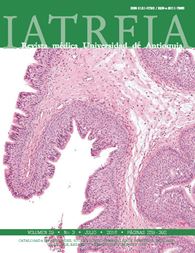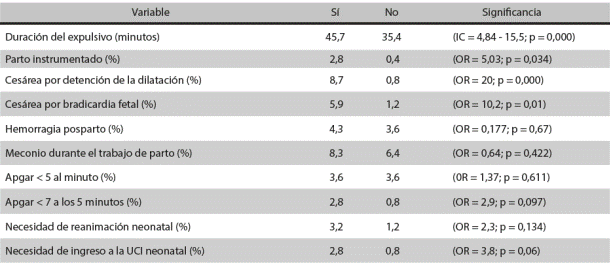Obstetrical and perinatal outcomes in patients with or without obstetric analgesia during labor
DOI:
https://doi.org/10.17533/udea.iatreia.v29n3a01Keywords:
epidural analgesia, labor, Neonatal Intensive Care Units, painAbstract
Objective: To describe and compare the obstetric and perinatal outcomes in patients with or without obstetric analgesia during labor, and to determine whether such analgesia is associated with adverse maternal or perinatal outcomes.
Methodology: Comparative, retrospective, descriptive study, between January and November 2014, that included 502 healthy patients with normal pregnancies, out of which 250 received obstetric analgesia. The groups were compared as to maternal and perinatal outcomes.
Results: Young, single and nulliparous mothers predominated; delivery was vaginal in 86 % of the cases, and by caesarean section in 14 %. Obstetric analgesia was associated with longer duration of the second stage of labor, instrumental delivery and cesarean section due to arrest of dilatation or fetal bradycardia; however, it was not related with higher incidence of postpartum hemorrhage or adverse perinatal outcomes such as meconium-stained amniotic fluid, Apgar under 5 at one minute or under 7 at 5 minutes, the need for neonatal resuscitation or for admission to NICU.
Conclusion: Obstetric analgesia increases the duration of the second stage of labor and can increase the rate of caesarean sections and instrumental delivery, but it is not associated with adverse maternal or perinatal outcomes. Therefore, its use in labor is justified.
Downloads
References
(1.) Chatrath V, Khetarpal R, Sharma S, Kumari P, Sudha, Bali K. Fentanyl versus tramadol with levobupivacaine for combined spinal-epidural analgesia in labor. Saudi J Anaesth. 2015 Jul-Sep;9(3):263-7. DOI 10.4103/1658-354X.154700.
(2.) ACOG Committee Opinion #295: pain relief during labor. Obstet Gynecol. 2004 Jul;104(1):213.
(3.) Hiltunen P, Raudaskoski T, Ebeling H, Moilanen I. Does pain relief during delivery decrease the risk of postnatal depression? Acta Obstet Gynecol Scand. 2004 Mar;83(3):257-61.
(4.) Soet JE, Brack GA, DiIorio C. Prevalence and predictors of women’s experience of psychological trauma during childbirth. Birth. 2003 Mar;30(1):36-46.
(5.) Eidelman AI, Hoffmann NW, Kaitz M. Cognitive deficits in women after childbirth. Obstet Gynecol. 1993 May;81(5 ( Pt 1)):764-7.
(6.) Seyb ST, Berka RJ, Socol ML, Dooley SL. Risk of cesarean delivery with elective induction of labor at term in nulliparous women. Obstet Gynecol. 1999 Oct;94(4):600-7.
(7.) Anim-Somuah M, Smyth R, Howell C. Epidural versus non-epidural or no analgesia in labour. Cochrane Database Syst Rev. 2005 Oct;(4):CD000331. Review. Update in: Cochrane Database Syst Rev. 2011; 12):CD000331.
(8.) Liu EHC, Sia ATH. Rates of caesarean section and instrumental vaginal delivery in nulliparous women after low concentration epidural infusions or opioid analgesia: systematic review. BMJ. 2004;328:1410-5. DOI 10.1136/bmj.38097.590810.7C.
(9.) Halpern SH, Muir H, Breen TW, Campbell DC, Barrett J, Liston R, et al. A multicenter randomized controlled trial comparing patient-controlled epidural with intravenous analgesia for pain relief in labor. Anesth Analg. 2004 Nov;99(5):1532-8.
(10.) Nielsen PE, Erickson JR, Abouleish EI, Perriatt S, Sheppard C. Fetal heart rate changes after intrathecal sufentanil or epidural bupivacaine for labor analgesia: incidence and clinical significance. Anesth Analg. 1996 Oct;83(4):742-6.
(11.) Ruppen W, Derry S, McQuay H, Moore RA. Incidence of epidural hematoma, infection, and neurologic injury in obstetric patients with epidural analgesia/anesthesia. Anesthesiology. 2006 Aug;105(2):394-9.
(12.) Kamath BD, Todd JK, Glazner JE, Lezotte D, Lynch AM. Neonatal outcomes after elective cesarean delivery. Obstet Gynecol. 2009 Jun;113(6):1231-8. DOI 10.1097/AOG.0b013e3181a66d57.
(13.) DANE Colombia [Internet]. Bogotá: Gobierno de Colombia; 2014 [consultado 2015 Jun 12]. Nacimientos 2014-Preliminar: Cifras con corte a 31 de enero de 2015. Cuadro 4. Nacimientos por tipo de parto según departamento de ocurrencia y sitio del parto. Disponible en: http://www.dane.gov.co/index.php/esp/component/content/article/118demograficas/estadisticas-vitales/5414-nac-2014
(14.) Clinical Management Guidelines for Obstetrician-Gynecologist. ACOG practice bulletin, clinical management guidelines for obstetrician-gynecologists. Obstet Gynecol. 2003 Dec; (49):1445-54.
(15.) Hansen SL, Clark SL, Foster JC. Active pushing versus passive fetal descent in the second stage of labor: a randomized controlled trial. Obstet Gynecol. 2002 Jan;99(1):29-34.
(16.) Anim-Somuah M, Smyth R, Howell C. [Analgesia epidural versus no epidural o ninguna analgesia para el trabajo de parto] Cochrane [Internet]. 2008;(2). Inglés. Disponible en: http://www.bibliotecacochrane.com/BCPGetDocumentForPrint.asp?DocumentID=CD000331
(17.) Aceituno L, Sánchez-Barroso MT, Segura MH, Ruiz-Martínez E, Perales S, González-Acosta V, et al. Influencia de la analgesia epidural en el parto. Clín Investig Ginecol Obstet. 2010 Jan-Feb;37(1):27-31. DOI 10.1016/j.gine.2009.02.007.
(18.) Lieberman E, O’donoghue C. Unintended effects of epidural analgesia during labor: a systematic review. Am J Obstet Gynecol. 2002 May;186(5 Suppl Nature):S31-68.
(19.) Leighton BL, Halpern SH. The effects of epidural analgesia on labor, maternal, and neonatal outcomes: a systematic review. Am J Obstet Gynecol. 2002 May;186(5 Suppl Nature):S69-77.
(20.) Garriguet J, Ruiz J, Lacal J, Gomariz MJ, Molleja P, Rodríguez MI, et al. Correlación de la analgesia epidural en el aumento de la tasa de cesáreas. Clin Invest Gin Obst. 2006 Feb;33(1):12-4. DOI 10.1016/S0210-573X(06)74075-8.
Published
How to Cite
Issue
Section
License
Copyright (c) 2016 Iatreia

This work is licensed under a Creative Commons Attribution-ShareAlike 4.0 International License.
Papers published in the journal are available for use under the Creative Commons license, specifically Attribution-NonCommercial-ShareAlike 4.0 International.
The papers must be unpublished and sent exclusively to the Journal Iatreia; the author uploading the contribution is required to submit two fully completed formats: article submission and authorship responsibility.















